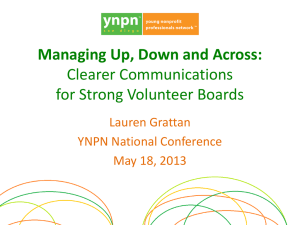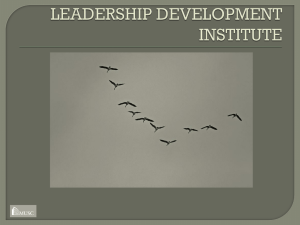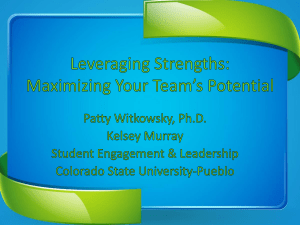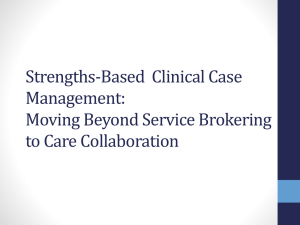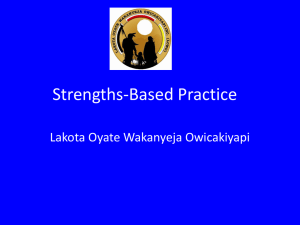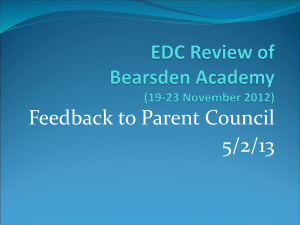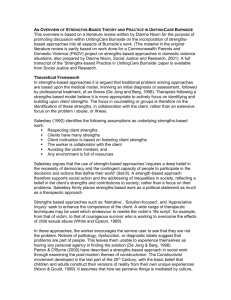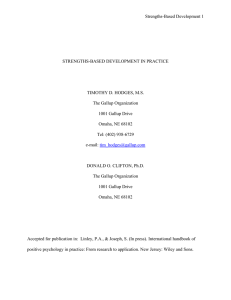Strength Based Coaching - Center for School Transformation
advertisement
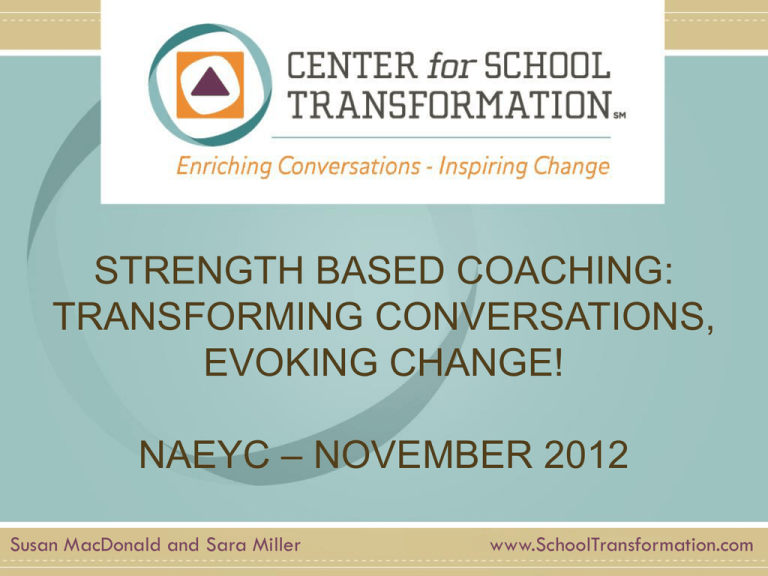
STRENGTH BASED COACHING: TRANSFORMING CONVERSATIONS, EVOKING CHANGE! NAEYC – NOVEMBER 2012 Susan MacDonald and Sara Miller www.SchoolTransformation.com CONVERSATIONS MATTER STRENGTH BASED FOCUS Increases Engagement Creates Collaborative Teams Improves Student Learning Increases Productivity Restores HOPE! MEG WHEATLEY “It takes courage to start a conversation. But if we don’t start talking to each other, nothing will change. Conversation is the way we discover how to transform our world, together.” TRADITIONAL DEFICIT-BASED PARADIGM Identifying Gaps Between Our Aspirations and Our Current Reality Search for Root Causes Culprits Generating Possible Solutions Plan of Action THE DOWNSIDE OF DEFICIT-BASED CHANGE o Drains energy and fosters discouragement o Fosters a culture of blame and negativity o Squelches creativity and innovation o Weakens relationships and collaboration o Focuses on the past rather than generating positive images of the future ALBERT BANDURA “It is far easier to discourage someone with our words than to encourage them.” IRVING BORWICK “People don’t resist change; they resist being changed.” THE UPSIDE OF STRENGTHS-BASED CHANGE Discovering and exploring strengths awakens curiosity, engagement, cooperation, and the alignment of organizational systems. It is a better way to change. TRANSFORMATIONAL PARADIGM Celebrating Current Areas of Strength Discovering Root Causes of Success Envisioning New Possibilities Innovating around What Brings Energy and Life CORE ASSUMPTIONS OF APPRECIATIVE INQUIRY What we focus on becomes our reality Vitality is always there to be discovered Asking questions influences those who answer; our questions are fateful People increase their confidence for change when they build on what they know. APPRECIATION MATTERS “The sparkle of good feelings awakens motivation to change.” ~ Barbara Fredrickson WHY IT’S GOOD TO FEEL GOOD Positive Actions & Outcomes Positive Energy & Emotion Positive Conversations & Interactions Positive Questions & Reflections Positive Anticipation of the Future Positive Attention in the Present WE FIND WHAT WE LOOK FOR Placebo Studies Pygmalion Effect UNDERLYING ASSUMPTIONS Vitality is always there to be discovered Our questions influence those who answer The first question is fateful People increase their confidence for change when they build on what they know “By celebrating what’s right, …we find the energy to fix what’s wrong. CONVERSATIONS FOR CHANGE “Calling forth motivation and movement in people, through conversation and a way of being, so they achieve desired outcomes and enhance their quality of life.” KEY PRINCIPLES Person-Centered No-Fault Strengths-Based PERSON-CENTERED CARL ROGERS “The person-centered approach rests on a basic trust in human beings, and in all organisms, to flow toward the constructive fulfillment of their inherent possibilities.” NO-FAULT Nonjudgmental Stance Mindful Listening Expressing Empathy Seeing the Beauty of the Needs MEG WHEATLEY “If you want to make change, host safe places for people to come together. Learning begins when people feel safe enough to take risks.” STRENGTHS-BASED MARCUS BUCKINGHAM “Excellence is not the opposite of failure. To learn about success you have to study success. Only successful examples can tell you what excellence looks like.” APPRECIATIVE INQUIRY A strengths-based approach to learning and working together that enables people to generate change at the speed of imagination ALBERT EINSTEIN “We cannot solve our problems with the same thinking we used when we created them.” TURNING TO STRENGTHS Initiate “What is the focus?” Aspiring, focusing & framing Clarifying Positive Core TRADITIONAL SWOT Strengths Opportunities Weaknesses Threats TRANSFORMATIONAL SOAP Strengths Observations Aspirations Possibilities REFRAMING THE FOCUS OF ATTENTION Deficit Issues Stress & Low Morale Isolation Low Achievement Irrelevant Professional Development Employee Turnover Affirmative Topics Highly Engaged & Motivated Extraordinary Collaboration High Engagement & Learning Exceptional Professional Learning Longevity THE SNOOPERVISOR ~ ANONYMOUS 1929 With keenly peering eyes and snooping nose, From room to room the Snoopervisor goes He notes each slip each fault with lofty frown. And on his rating card, he writes it down; His duty done when he has brought to light, The things that teachers do that are not right. The supervisor enters quietly, “What do you need? How can I help today? John, let me show you. Mary try this way.” She aims to help, encourage and suggest, That the teachers, pupils may do their best. , SHIFTING PERSPECTIVE SHIFTING PERSPECTIVE LISTEN - RALPH ROUGHTON, M.D. When I ask you to listen to me and you start giving advice, you have not done what I asked. When I ask you to listen to me and you begin to tell me why I shouldn’t feel that way, you are trampling on my feelings. When I ask you to listen to me and you feel you have to do something to solve my problems you have Failed me, strange as that may seem. Listen, all I asked was that you listen – not talk or do, just hear me. When you do something for me that I can and need to do for myself, you contribute to my fear and inadequacy. But when you accept as a simple fact that I do feel what I feel, no matter how irrational, then I can quit trying to convince you and can get about the business of understanding what’s behind this irrational feeling. And when that’s clear, the answers are obvious and I don’t need advice. Irrational feelings make PAIRED INTERVIEWS Share a “high-point” moment from the past 6 – 12 months. What was the situation? What happened that made you aware of your strengths? Share the three best qualities that the people close to you would share if they were asked about you? Choose one of your strengths and remember a time when you lived up to that strength? What happened? How did working to that strength impact your perception of time, productivity and work satisfaction? How will you continue to develop your strengths? What possibilities can you imagine when you amplify your strengths? What excites you about using this strength based approach with teachers? DIVING INTO STRENGTHS Initiate “What is the focus?” Aspiring, focusing & framing Clarifying Positive Core Inquire “What gives life?” Noticing, valuing & understanding Appreciating GENERATES NEW POSSIBILITIES The more we know about our strengths, the better our changes will be. LEARNING FROM STRENGTHS Fairness Creativity Love of Learning Curiosity Love Hope Appreciation of Beauty Forgiveness Open-Mindedness Prudence Self-Regulation Leadership Teamwork Bravery Honesty & Authenticity ZEST Humor MODESTY Social Intelligence Kindness Perseverance Spirituality / Religiousness Perspective LEARNING FROM SELF-OBSERVATION LEARNING FROM SUCCESS Neurons became more “finely tuned” in the wake of success whereas “failure generated virtually no change in neural processing at all.” MARILEE ADAMS “A world of questions is a world of possibility. We have only to ask the right questions to begin.” ASKING STRENGTHS-BASED QUESTIONS Best Experiences Core Values Supporting Conditions Three Wishes ANTOINE DE SAINT EXUPERY “If you want to build a ship, don’t drum up people to gather wood, give orders, and divide the work. Instead, teach them to yearn for the vast and endless sea.” AMPLIFYING STRENGTHS Initiate “What is the focus?” Aspiring, focusing & framing Clarifying Positive Core Imagine “What might be?” Visualizing, expressing & brainstorming Envisioning Inquire “What gives life?” Noticing, valuing & understanding Appreciating POSITIVE IMAGES POSITIVE ACTIONS Heliotropic Principle Emotional Resonance Affirmative Cognition Self-Efficacy Collective-Efficacy Reinforcing Cycle JACK NICKLAUS “I’m going to hit it right down the middle of the fairway.” TAMES THE FRENZY IMAGES THAT INSPIRE ACTION Grounded Provocative Desired Proleptic Participatory CULTIVATES POSITIVE RELATIONSHIPS Builds Trust Communicates confidence Shifts conversations Reveals silver linings Gets people into flow ENGINEERING THE EXPERIENCE Initiate “What is the focus?” Aspiring, focusing & framing Clarifying Innovate “What will be?” Choosing, prototyping & engineering Co-Constructing Positive Core Imagine “What might be?” Visualizing, expressing & brainstorming Envisioning Inquire “What gives life?” Noticing, valuing & understanding Appreciating DESIGN THINKING FORMULA INNOVATION = INSPIRATION + IDEATION + IMPLEMENTATION COACHING WITH STRENGTHS Brainstorming possibilities Prototyping solutions Orchestrating quick wins Reframing setbacks Repeating success GENERATES DEMONSTRABLE GAINS A strengths-based focus on development has been shown to increase: Employee Engagement Student Learning Attendance Productivity Hope TIM BROWN “You need to be optimistic in order to be creative. And confident. In fact, if you don’t have confidence that you can create solutions, you won’t create solutions.” INSPIRATIONS FOR BRINGING STRENGTH BASED COACHING TO YOUR DAILY WORK! www.SchoolTransformation.com
